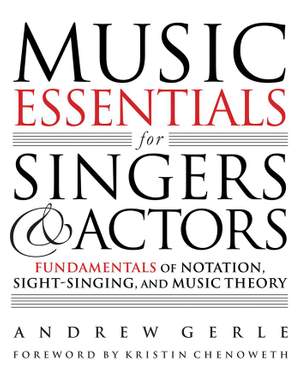Music Essentials for Singers and Actors: Fundamentals of Notation, Sight-Singing and Music Theory
- Author: Gerle, Andrew
Book
$54.00Contents
- Foreword by Kristen Chenoweth Author's Note
- 1. Willkommen A Little Brains, a Little Talent: the ingredients for a career Racing with the Clock: how to make the most of your rehearsal time Side by Side: an artistic collaboration with the writer The Sound of Music: the elements of musical notation W
- 2. I Got Rhythm: fundamentals The Rhythm of Life: how we divide time You Can't Stop the Beat: first definitions, quarter notes Just in Time: time signatures, note shapes The Speed Test: metronomes and their use Breathe: rests
- 3. In Short: smaller note values Tonight at Eight: the eighth note We Go Together: beams A Little Bit Off: off-beats and "and"s I'm Old Fashioned: vocal notation in older scores Pretty Little Picture: musical "words" and syncopation Small World: the sixt
- 4. Hold On: ties and dots Married: ties Stay with Me: dots
- 5. Play a Simple Melody: the piano keyboard, notes, clefs, and staves I Love a Piano: finding notes on the keyboard I Could Write a Book: writing notes on the staff Me, Who Am I?: clefs, letter names, and the grand staff You Will Be Found: matching notes
- 6. I've Got Your Number: intervals and scale degrees Go the Distance: basic interval sizes and names Home: the tonic and scale degrees Steppin' Out with My Baby: singing with scale degrees Do-Re-Mi: the Kodaly method
- 7. You Do Something to Me: accidentals, key signatures, and transposition I am Changing: accidentals and the black keys of the piano Ring of Keys: the major scale, key signatures, and the circle of fifths They Just Keep Moving the Line: transposing songs
- 8. So Big/So Small: identifying and singing every interval type
- 9. Fascinatin' Rhythm: cut time, triplets, swing; compound, composite and irregular meters Two by Two: cut time Squeeze me: triplets and grace notes By Threes: compound meter It Don't Mean a Thing: swing notation Unusual Way: irregular and composite meter
- 10. Let It Sing: combining your ear and your eye for increased fluency Doin' What Comes Natur'lly: diatonic versus chromatic melodies Do You Want to Build a Snowman?: triads and inversions Far from the Home I Love: strategies for chromatic melodies
- 11. Changing My Major: minor keys Three Friends: the minor scales Sing Happy: minor scales in context Show Me the Key: distinguishing between minor and major keys Sisters: minor, diminished, and augmented triads
- 12. I Know Things Now: combining multiple techniques to form a coherent strategy for reading What Comes Next?: reading ahead 1-STARRT at the Very Beginning: a method for analyzing and annotating any new song
- 13. No One Is Alone: singing with other performers Here I Am: finding your starting note I'm a part of That: consonance and dissonance with the piano accompaniment; piano/conductor scores Do You Hear the People Sing?: choral singing and score layouts
- 14. The Writing on the Wall: musical markings, repeat structure, and other score "road maps" Be Italian: tempo markings Loud: dynamic and articulation markings Stop, Time: pauses and held notes Speak Low: other expressive markings and spoken text Back to
- 15. Hey, Look Me Over: close score reading for dramatic and character analysis Mama, Look Sharp: every mark is a choice The Wrong Note Rag: analyzing dissonance and contour to color your performance Watch What Happens: dramatic inspiration from the piano
- 16. I Have Confidence: continuing to practice and consolidate your technique I Can See It: eye-training exercises A Trip to the Library: the joys of reading music alone and with others



